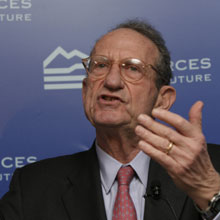The Precarious Future of Coal
Energy experts from MIT have released a long-awaited report on the future of coal. The report recommends that much more be done to develop technology for decreasing the impact of burning coal on global warming. The report also challenges some conventional thinking about the best way forward. It criticizes current efforts by the Department of Energy (DOE) and calls for an approximately $5 billion, 10-year program to demonstrate technology for capturing and storing carbon dioxide released by coal-fired power plants.

The report, based on a study by 13 MIT faculty members, comes at a time when growing concerns about global warming are making it increasingly likely that governments worldwide will impose a price on carbon-dioxide emissions to force a cut in the release of this important greenhouse gas. Nevertheless, coal, the leading source of carbon-dioxide emissions from electricity generation, will continue to be a major source of electricity, say the authors of the report. That’s because even with a high price on carbon, coal is abundant and probably necessary to meet fast-growing demand for energy worldwide.
Reducing the impact of continued coal use on global warming will require a massive effort to collect carbon dioxide from power plants and bury it underground, the experts say. The volume of compressed carbon dioxide that will need to be captured and transported is similar in scale to the amount of oil consumed in the United States, the report says.
Doing so is “not simply a matter of bolting on a box to capture carbon dioxide,” says John Deutch, a professor of chemistry at MIT. Indeed, retrofitting existing plants will require wholesale restructuring, even for advanced coal plants, he says. And although there are a few carbon-sequestration projects going on around the world, none of these has been put together with the sort of careful monitoring required to assure the public and energy investors that long-term, extremely high-volume carbon-dioxide storage is possible.
The report challenged the idea, argued by some energy experts, that a new type of coal plant–one that converts coal into a gas before burning it–will make it easier and cheaper to capture carbon dioxide, compared with collecting it from the smokestacks of conventional power plants. The MIT experts say that several factors make the picture more complicated. Such coal gasification doesn’t work well with low-grade coal, for example, and both the new and the conventional plants will require major changes to capture carbon dioxide, according to the MIT report.
As a result, the MIT researchers recommend that governments not support the new gasification plants over conventional plants. Instead, they say that governments should focus on large-scale demonstration programs that would, for the first time, capture carbon dioxide from coal plants, transport it, and store it at a large scale. The project would need to handle a million tons of carbon dioxide. Such demonstrations would make it possible to compare different technologies, increase policymaker and public confidence that capture and sequestration technology can work, and pave the way for quick adoption of the best technologies in response to a price on carbon dioxide.
Without such a demonstration, warns the report, a rush to cut carbon emissions would lead to spiking costs and further delays, and that would make it difficult for power producers to meet energy demand.
Although the DOE does spend a significant part of its resources on developing cleaner coal technology, the researchers say the agency’s efforts are underfunded and not focused on the most promising approaches. For example, the DOE strategy promotes advanced coal plants that do not include carbon-dioxide capture technology. And although the DOE’s FutureGen project has the potential to be a large-scale demonstration of power generation and carbon sequestration, its emphasis has been on research, not on the sort of work that will reveal system costs, the MIT authors say.
The demonstration projects the MIT researchers envision will take years. Meanwhile, the researchers suggest that governments take action by establishing a carbon-control policy. That will include, among other things, closing a potential loophole that may encourage utilities to build coal plants now without carbon capture in the hope that they can avoid future regulations.
Keep Reading
Most Popular
Large language models can do jaw-dropping things. But nobody knows exactly why.
And that's a problem. Figuring it out is one of the biggest scientific puzzles of our time and a crucial step towards controlling more powerful future models.
How scientists traced a mysterious covid case back to six toilets
When wastewater surveillance turns into a hunt for a single infected individual, the ethics get tricky.
The problem with plug-in hybrids? Their drivers.
Plug-in hybrids are often sold as a transition to EVs, but new data from Europe shows we’re still underestimating the emissions they produce.
Google DeepMind’s new generative model makes Super Mario–like games from scratch
Genie learns how to control games by watching hours and hours of video. It could help train next-gen robots too.
Stay connected
Get the latest updates from
MIT Technology Review
Discover special offers, top stories, upcoming events, and more.